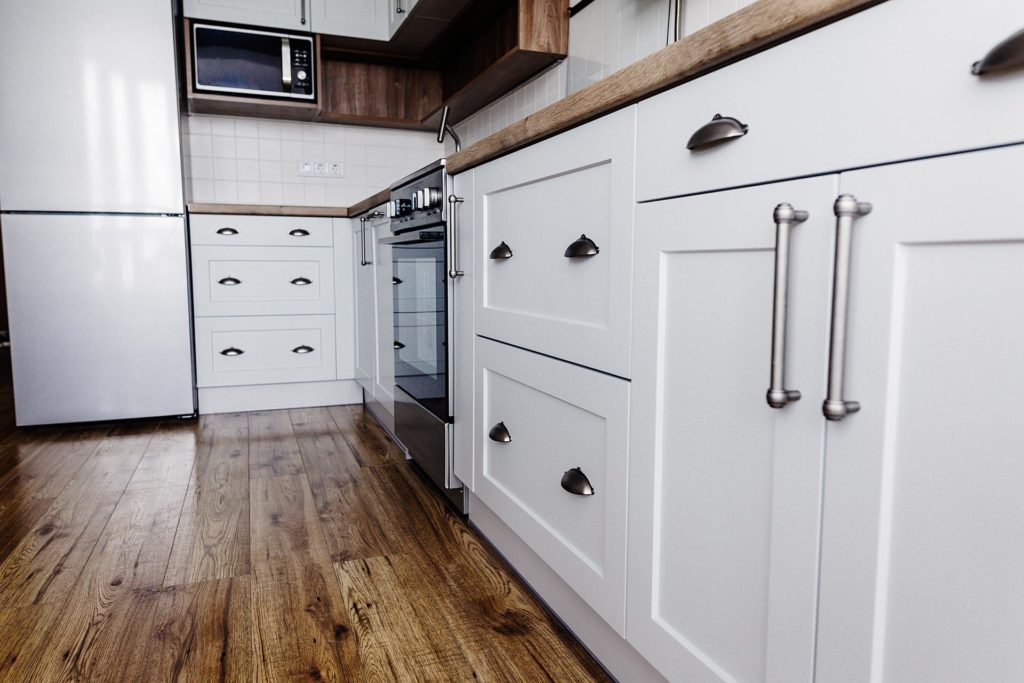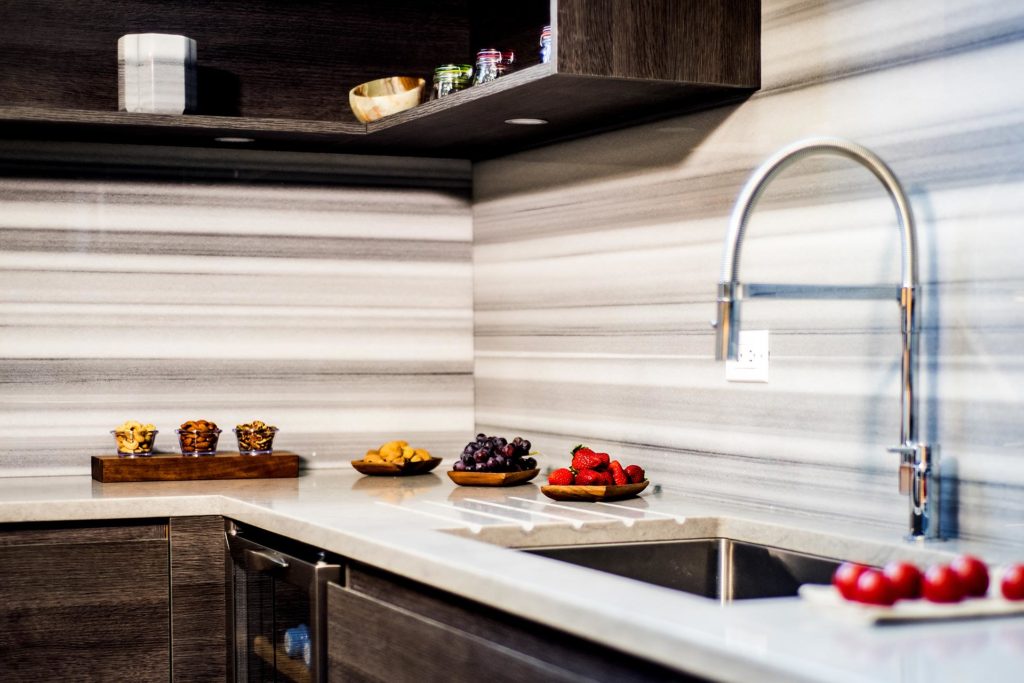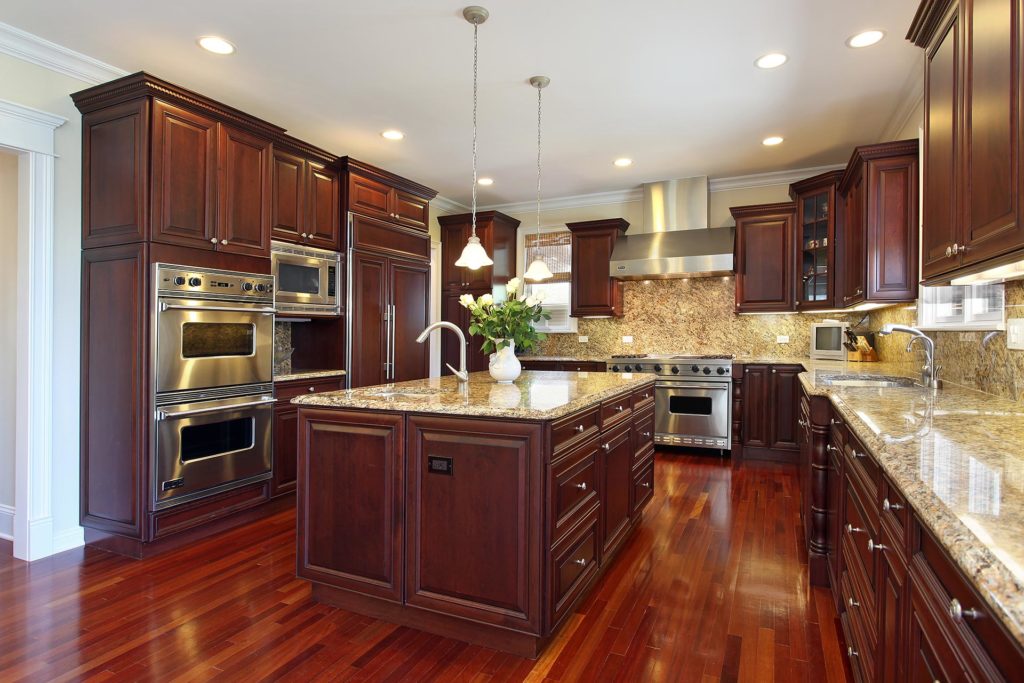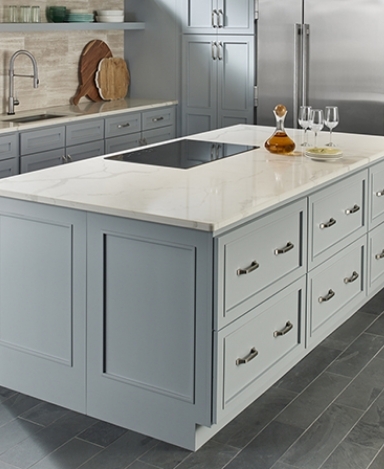Keeping your countertops in good shape is about more than just preserving the luster of a surface! It is possible to harm a countertop in the process of cleaning it, if you use the wrong types of cleaning solutions, or use something abrasive to scrub away a stain. In this blog, we’ll discuss some basic advice when it comes to caring for your countertops.
Cleaning up your countertops – Different materials require different types of care
There are a wide range of materials used for countertops today. At Express Reface, we specialize in quartz and granite countertops, two of the most popular options on the market today. But there are counters made from ceramic tile, soapstone, marble, and even concrete, and every one of these materials has different attributes.
Some countertops are more absorbent than others, which affects their resistance to stains. Others may be more susceptible to acidity, while others still may have greater impact tolerance. These differences make for challenges during food preparation and the regular maintenance and cleaning you should be performing.
For example, quartz countertops are made from a mixture of quartz stone material and adhesive resin. It will react differently to abrasive cleaning solutions and scrubbing pads compared to granite slabs. A ceramic tile countertop may resist staining, but if the seal for the grout in between the tiles has worn away, it may be susceptible to mold, mildew, or bacterial growth, in addition to difficult to remove stains.
Even temperature is a major concern. A very hot cooking pot could leave a circular burn on a quartz countertop, while a granite one may withstand it for longer before it causes damage.
By knowing how to properly maintain the material your counters are made from, it will be easier to keep them clean. But more importantly, you’ll avoid causing accidental damage, and ensure your countertops last for many years.

How to properly clean quartz and granite countertops.
Express Reface specializes in two materials for countertops: quartz and granite. Both boast incredible strength and overall durability, and with the right care, they can stay looking good as new for decades. The differences between these two materials, and how they are crafted into countertop slabs, influences how you should clean and maintain them.
Quartz
Quartz is presently the most popular countertop material on the market today. This engineered stone is naturally non-porous, thanks to how it is fabricated, and therefore it will be considerably more stain resistant. There is no need for resealing, and the countertop will be far more resistant to bacteria, mold, and mildew, compared to other materials.
For day-to-day cleaning: Everyday cleaning is as simple as dusting or wiping down the countertop. We recommend using mild dish soap and water, along with a soft, non-abrasive rag. This is the best way to remove dust, liquids, and crumbs, without scratching the surface.
If you are using cleaning sprays or other liquid solutions, make sure they are formulated for quartz countertops. Glass cleaner and other non-abrasive household cleaners are also fine. You can also use degreaser to handle any grease spills.
For liquid spills: The non-porous nature of quartz countertops mean that spills are somewhat less urgent, as there isn’t the risk of staining that materials like granite or grout have. However, if the liquid is acidic—tomato juice, vinegar, etc.—you should clean up spills as quickly as possible to avoid damage.
Avoid cleaning solutions that are acidic or alkaline. These can cause damage to the countertop surface. Bleach should also be avoided, as it can not only damage the counter surface, but also cause permanent discoloration.
Granite
While no longer as popular as quartz, granite countertops still offer great natural beauty without sacrificing overall durability. However, where a quartz slab is manufactured to be non-absorbent, granite is a naturally occurring porous rock. Some varieties of granite are more susceptible to stains from spilled food and drinks, while darker color varieties are dense enough to have natural resistance to stains.
Some granite slabs are impregnated with a sealant to give them greater stain resistance. But this sealing does fade over time, and can be weakened through regular use of harsh cleaning solutions.
For day-to-day cleaning: A good microfiber cloth is enough to handle dust or dry food crumbs. You can buy special cleaning solutions that are formulated for use on stone surfaces. Alternatively, you can use a diluted mixture of dishwashing detergent, mixing 1 teaspoon with four cups of water in a spray bottle. When you do use a spray, make sure to wipe it away quickly, and that no liquid is left on the counter surface.
For liquid spills: It is best to NOT wipe them, especially if they are dark liquids with a high potential to cause stains, such as ink, red wine, or beet juice. You’re just potentially spreading the area of the stain. Instead, use paper towels or cloth to dab the spill off the surface.
Avoid all harsh chemicals, abrasives, and generic glass cleaning products. These can include bleach or ammonia, both of which can dull the finish of the granite and compromise sealing. They can also pit and etch these surfaces, and this kind of damage cannot be easily hidden or repaired.
This also means that acidic food and liquids should be handled with care. If coffee or citrus juice spills onto granite, dab it off the surface as soon as possible. A properly sealed countertop can resist staining, but failing to clean up these spills in a timely manner can result in difficult to remove stains.
How to prevent and remove stains from your countertop.
Regardless of the type of countertops you have in your home, the best way to prevent stains is to quickly clean up spilled food and liquid.
As we’ve mentioned above, quartz countertops are naturally more resistant to staining, as they are engineered to be less absorbent. Stains also tend to be easier to address on quartz surfaces.
With granite, however, it depends on the type of granite slab used, and the condition of the seal. A properly sealed granite slab, even those that are lighter colored and more absorbent, can resist stains well enough. But it is more important to clean up spills on granite quickly to avoid testing just how good that seal really is!
If the worse does happen and a stain develops on your countertop, there are things you can do to try and remove them.
If the stain is on a quartz countertop:
For most light stains, mixing warm water with a small amount of dish soap is a good solution. This can loosen the material of the stain, allowing it to be easily wiped away. Isopropyl rubbing alcohol, along with a wet towel or cloth, can also be used to remove surface stains.
If water and dish soap aren’t doing the trick, an adhesive remover like Goo Gone will work on a quartz countertop without causing damage to the surface. Pour your chosen remover (after ensuring it is safe for use on quartz) over the stain, and let it stand for 5-10 minutes, depending on how stubborn the stain is. Afterwards, wipe up the Goo Gone (and hopefully the stain), then use warm water and a soft cloth to wipe down the surface again.
Quartz-safe glass cleaner can also work. Spray the stained surface with the liquid, let it stand for several minutes, then wipe down. Repeat as necessary.
For spots of dried liquids, such as paint, ink, and nail polish, or for foods stuck to the countertop, you can use a putty knife to carefully scrape it away. Just be certain to avoid striking the countertop with the knife.
If your granite countertop has been stained:
The first order of business when dealing with a granite stain is to determine if the discoloration is a stain or surface damage. It’s possible to lift stains out of granite, but physical damage is much harder to conceal, much less repair.
If you’re dealing with a stain, first identify what caused it. Knowing what type of spill you’re dealing with will also determine how best to clean it. You can break down stains into the following categories:
- Organic – Sodas, fruit juice, coffee, and wine can all cause frustrating stains. You can use 12% hydrogen peroxide and drops of ammonia, coupled with light scrubbing, to clean these stains.
- Inorganic – Ink, dyes, nail polish, and magic markers can stain granite. Rubbing alcohol can be used on these stains. Hydrogen peroxide is also an option, but this should be limited to lighter colors of granite.
- Oil – Cooking oils, butter, and certain types of mineral oil cause stubborn stains that need to be chemically dissolved so they can be rinsed off the counter surface. These stains can be addressed with a liquid cleaner containing ONE of the following: acetone, ammonia, bleach, household detergent, or mineral spirits.
- Biological – Mildew, mold, and bacteria can stain granite. These stains can be with a solution made from a gallon of water, and 1/2 cup of ONE of the following: bleach, hydrogen peroxide, or ammonia. Note: DO NOT mix ammonia and bleach, because this WILL produce toxic chlorine gas!
- Metal – Rust from metal in contact with the granite is one of the most difficult types of stains to remove. A poultice is required for metal stains, but even with poultices or professional help, some metal stains may be impossible to fully remove.
For surface stains: You can use a mixture of dish detergent, warm water, and a soft brush to break up the stain with some light scrubbing. If that isn’t good enough, you can use one of the solutions listed for the type of stain you’re dealing with. This will not be effective against metal stains.
For stubborn stains: If the above doesn’t completely eliminate the stain, you can use a paste made from baking soda and water or alternatively, talc mixed with diluted ammonia, hydrogen peroxide, or bleach (1/2 a cup of ONE of those solutions mixed into 1 gallon of water. Remember that you cannot mix ammonia and bleach, as this make a deadly gas!).
Once again, use a soft brush to try scrubbing away the stain. Note that this can affect the sealing of a granite slab, so you will want to reseal afterwards.
Use a poultice if the stain is particularly tenacious: If the above methods don’t work, or you are dealing with a metal stain, a poultice can extract the stain from granite. Hardware stores sell premade poultices formulated for granite countertops and different types of spills. You can also make your own poultice, using specific materials depending on the type of stain.
Whether you’ve purchased or made a poultice, you need to apply it directly to the stain using a spatula or other similar tool. It should be a quarter of an inch thick, and extend beyond the edges of the stain by about half an inch. You’ll then want to cover the poultice with plastic wrap. Tape down the wrap, and let the poultice stand until it is dry. This can take over 24 hours, depending on how much you have applied.
Once it is dry, use a plastic scraping tool to gently remove the poultice, wipe away any residue, and use another wet cloth to further wipe down the area. If the stain is still visible, you will need to repeat this process. As with the previous stain removal method, this can compromise the seal of the granite and dull the finish. You will want to reseal the area treated with the poultice.
How to tell if your granite countertops needs a seal applied.
A seal is what gives granite slabs additional resistance to stains and water absorption. But over time, cleaning, exposure to sunlight, and plain wear and tear will weaken the seal.
Many homeowners regularly reseal granite, though the frequency or necessity of this can depend on the type of granite. Darker slabs of granite can be naturally stain-resistant enough that a seal isn’t required. Some varieties of granite are naturally so resistant to liquid absorption that they don’t seal well, as a seal will not penetrate very far, if at all, into the slab. But there is no such thing as ‘over-sealing’ granite, as it can help the slab maintain its luster and still work to prevent dust or liquid stains.
You can check if your granite needs to be sealed by performing a simple test with some water once or twice a year. Spray water on the granite surface, then check it every five minutes. If the surface darkens rapidly after applying the water, you should apply a seal as soon as possible. But if after thirty minutes the counter appears unaffected by the water, either the seal is good or the granite is not very absorbent.
Protecting your countertops from physical damage.
All countertops are capable of resisting some physical abuse, but they have limits. There are some general tips you can use to prevent serious damage to your counters, regardless of the material you’re using.
- Use a cutting board: While it is perfectly possible to prepare food directly on a countertop, you’re basically asking to chip or crack the material with an errant swing of a utensil. Not to mention, if the food in question is acidic, you could cause more subtle etching damage to the surface.
- Avoid applying extreme heat directly to the countertop: Whether you’re moving a hot pot from a stove, or are setting down a curling iron, excess heat can cause permanent damage to the slab. Even granite, which is particularly heat resistant, can crack due to rapid heating or cooling. Use a trivet for pots and pans, and let hot appliances cool down before setting them on your counters.
- Watch how much weight you put on the counter: As sturdy as countertops look, excessive weight can cause fractures to weaker portions of a slab. Don’t kneel or stand on your counter to reach a high shelf. Use a stepladder instead.
- Store liquids and toiletries away from your counters if you can: We’ve all spilled a little hand sanitizer or soap on the bathroom counters when we’re in a hurry. Cooking oils can spill when we’re working fast. Mouth wash can drip from its bottle. By stowing away as much of these liquids as you can, you can minimize accidental spills.
By following the advice in this article, you can ensure that your countertops will stay in great shape, stay sanitary, and look good as new for years to come!






